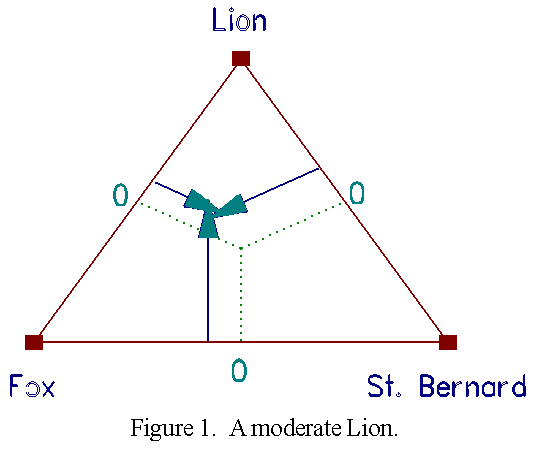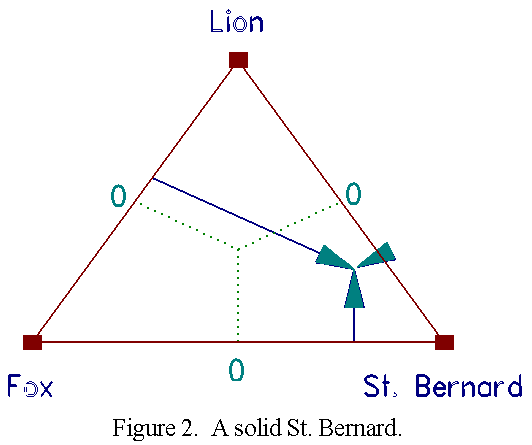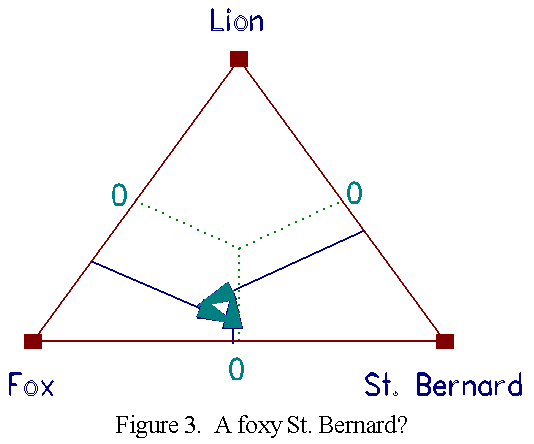
Bi-polar psychological constructs, such as Jung's introversion- extraversion, can be expressed as measures on a unidimensional variable of "differential amount of". Multi-polar constructs are more of a challenge to report in an easily understood way.
According to Porter's (1973) Relationship Awareness Theory, there are three motivational patterns exhibited by team members. The assertive- directing pattern, symbolized by a lion, is exhibited by individuals who seek gratification through leading others. These individuals organize team resources, and expect to benefit from team success. The analytic-autonomizing pattern, symbolized by a fox, works towards logical order and meaning in action. These individuals focus on data collection and analysis. They expect to be paid for their work. The altruistic-nurturing pattern, symbolized by a St. Bernard dog, helps others with little interest in their own material advancement. When participating in a team, every team member exhibits more or less of all three patterns, but how much?
To investigate Porter's theory, I constructed a 15 item self- administered "team member inventory". Each item has a stem and three options, one for each pattern. For instance, one item is:
If someone were to describe what role you tend to play in a group,
would it be
a) fact-finding analyzer?
b) supportive hard-worker?
c) driven decision-maker?
The respondent chooses one option. The key for this item (unknown to the respondent) is a=(F)ox, b=St. (B)ernard, c=(L)ion. Each item is answered twice: once for a safe and secure team environment, and again for a dangerous, risky environment. The resulting data set consists of 30 data points per respondent, with each response coded L, F or B.
In order to understand what my respondents are telling me about themselves, I decompose the tri-polar theory into three bi-polar constructs. Each pair of patterns (animals) represents opposite ends of a latent variable on which each respondent can be located. Thus, to locate respondents on the Lion-Fox construct, any response coded "L" indicates more lion-ness. Any response coded "F" indicates more fox-ness, i.e., less lion-ness, and any response coded "B" is treated as missing data. Rasch analysis of the three bi-polar constructs yields three measures for each respondent: a Lion/Fox measure, a Fox/St. Bernard measure, and a St. Bernard/Lion measure.
A useful communication device for these three measures is an equilateral triangle. Each bipolar variable is rescaled and centered on one of the sides. In my examples, the vertices are 8 logits apart. The three Figures illustrate three actual profiles. Figure 1 depicts a typical respondent whose moderate behavior is somewhat lion-like. The measures are Fox/St.Bernard, 0.24 logits; Lion/Fox, 0.10; and St.Bernard/Lion, -0.60. To place these measures in the triangular diagram, each measure is located on its side, and a line perpendicular to the side is drawn from that point. The intersection of the lines forms a smaller equilateral triangle. The center of this triangle summarizes the respondent's tri-polar behavior.

Figure 2 shows a conspicuously St. Bernard-like profile. Figure 3 shows someone whose placement, while somewhat indefinite, avoids Lion- like behavior.
There is more information in the responses, but these Figures provide a quick initial summary and classification, informative to the team manager.


Lions, foxes and St. Bernards. Williams, Evelyn. … Rasch Measurement Transactions, 1994, 8:2 p.351
| Forum | Rasch Measurement Forum to discuss any Rasch-related topic |
Go to Top of Page
Go to index of all Rasch Measurement Transactions
AERA members: Join the Rasch Measurement SIG and receive the printed version of RMT
Some back issues of RMT are available as bound volumes
Subscribe to Journal of Applied Measurement
Go to Institute for Objective Measurement Home Page. The Rasch Measurement SIG (AERA) thanks the Institute for Objective Measurement for inviting the publication of Rasch Measurement Transactions on the Institute's website, www.rasch.org.
| Coming Rasch-related Events | |
|---|---|
| Jan. 16 - Feb. 13, 2025, Fri.-Fri. | On-line workshop: Rasch Measurement - Core Topics (E. Smith, Winsteps), www.statistics.com |
| Apr. 8 - Apr. 11, 2026, Wed.-Sat. | National Council for Measurement in Education - Los Angeles, CA, ncme.org/events/2026-annual-meeting |
| Apr. 8 - Apr. 12, 2026, Wed.-Sun. | American Educational Research Association - Los Angeles, CA, www.aera.net/AERA2026 |
| May. 15 - June 12, 2026, Fri.-Fri. | On-line workshop: Rasch Measurement - Core Topics (E. Smith, Winsteps), www.statistics.com |
| June 19 - July 25, 2026, Fri.-Sat. | On-line workshop: Rasch Measurement - Further Topics (E. Smith, Winsteps), www.statistics.com |
The URL of this page is www.rasch.org/rmt/rmt82b.htm
Website: www.rasch.org/rmt/contents.htm